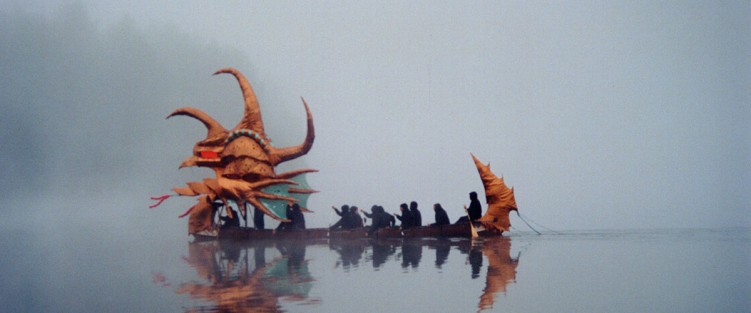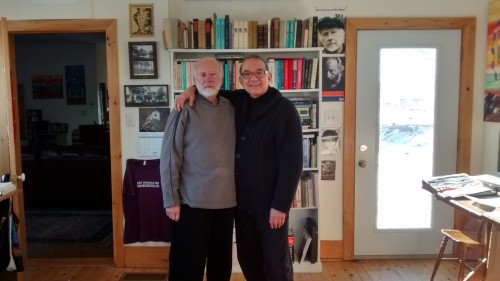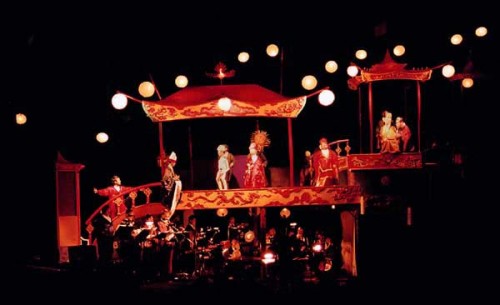 “Murray had the tendencies of a renegade and rascal, but one with a benevolent and honourable artistic purpose in mind,” wrote Esprit Orchestra conductor and music director Alex Pauk, in a September 10, 2021 remembrance for The Globe and Mail. And Pauk should know, having, by his own count, conducted more than 80 performances of R. Murray Schafer’s music over the years, with Esprit and other orchestras.
“Murray had the tendencies of a renegade and rascal, but one with a benevolent and honourable artistic purpose in mind,” wrote Esprit Orchestra conductor and music director Alex Pauk, in a September 10, 2021 remembrance for The Globe and Mail. And Pauk should know, having, by his own count, conducted more than 80 performances of R. Murray Schafer’s music over the years, with Esprit and other orchestras.
“He was a consummate artist – a no-holds-barred kind of guy who’d never take on a project or cause without his total commitment” Pauk went on later to tell me. “He’d always be straight and never let you down once he agreed to work with you. ”
Esprit was not the start of their relationship though. They had already met, a decade before Esprit was founded – a meeting that Pauk, in his Globe remembrance, credits with setting Pauk on his long-term musical path. “[It was] 1973, when I moved to Vancouver and made an appointment to see if he’d hire me for his World Soundscape Project at Simon Fraser University,” Pauk writes.
And Schafer’s response as Pauk remembers it? “Alex, don’t get involved in academia – just go on being a conductor and composer – a much better thing for you to do!”
 Esprit’s founding, a decade later, anchored a lifelong relationship between the two men, creating a whole repository of “Murray stories” to confirm Pauk’s “renegade and rascal” characterization of Schafer. One is mentioned in the Globe story: the composition North/White in which pristine layers of orchestral sound depicting the purity of the Arctic environment are gradually overpowered by sounds of chains and oil drums, culminating with a roaring snowmobile that shows up in the percussion section to represent the deluge of industrial activity brought to Northern Canada by humans. “The audience goes from laughing to spellbound,” Pauk writes, “enthralled at the piece’s powerful, searing visual and sonic imagery having a serious environmental message.”
Esprit’s founding, a decade later, anchored a lifelong relationship between the two men, creating a whole repository of “Murray stories” to confirm Pauk’s “renegade and rascal” characterization of Schafer. One is mentioned in the Globe story: the composition North/White in which pristine layers of orchestral sound depicting the purity of the Arctic environment are gradually overpowered by sounds of chains and oil drums, culminating with a roaring snowmobile that shows up in the percussion section to represent the deluge of industrial activity brought to Northern Canada by humans. “The audience goes from laughing to spellbound,” Pauk writes, “enthralled at the piece’s powerful, searing visual and sonic imagery having a serious environmental message.”
Another example of what Pauk calls Schafer’s “mischievous ways” dates back to 1971 – Schafer’s piece No Longer Than Ten Minutes, commissioned by the Toronto Symphony Orchestra. Strategically placed at the beginning of the concert so as not to unsettle audiences, such commissions had contractual stipulations for the piece’s duration possibly aimed at fulfilling content quotas for government support without too much impact on the audience’s tolerance for new music. “But, audaciously, Schafer’s score specified that at the end of the piece, with its tam-tam fadeouts, each time the audience began applauding, the percussionists should begin a new rolling tam-tam crescendo and fadeout. Each fadeout therefore, would lead to a new wave of sound if the audience began applauding. Thus ensued a loop that could go on for much longer than ten minutes.”
Just naughty or with a deeper intent? “Certainly we can chalk it up to Murray being a trickster with a hilarious sense of humour, but definitely with a deeper intent to make people aware of time, contemplate the piece they’d just experienced and/or consider the relationship between composers, orchestras and audiences? It only works because it is actually a fine piece of music – not just a gimmick. But the audience at the premiere sure was confused!”
The Quiver of Life, 1979
“Music keeps us in touch with this entire vibrating world both outside and in,” says Yehudi Menuhin, almost exactly 17:30 minutes into the first episode, titled The Quiver of Life, of his eight-part documentary series called, comfortably at the time, The Music of Man. As he says the words, the camera cuts from a groomed European cottage garden to a farm hillside near Bancroft, Ontario.
“This is what I would call a hi-fi soundscape, in which the signal to noise ratio is very favourable,” says Schafer to Menuhin, as they stand there, listening deeply. “There are very few noises here and therefore every sound around us can be heard, even at a very great distance ... the city by contrast is very low-fi soundscape – that is to say there are so many noises that it’s very hard to determine what the signals are.”
“Although I had heard of Murray Schafer’s soundscapes I never knew what fun they could be,” says Menuhin, in voice-over as, a couple of minutes further into the episode, they enter Schafer’s Bancroft barn. What follows is six or seven minutes of hilarity interspersed with profundity as they activate the gigantic musical apparatus, built specifically for Menuhin’s visit, by riding a teeter-totter in the middle of it. “It’s a lesson in listening isn’t it,” says Menuhin to Schafer as they catch their breath. “It’s something every child should have recourse to … the best training in the world.” Schafer’s reply reveals the teacher in him: “Actually what they should do is build one, because when you build a thing you discover the properties of sound that are inherent in each object.”
And then he follows with another pedagogical insight: “If you take a group of kids out into the woods, and say ‘ok we are going to listen to the sounds’ then of course what everyone will do is to talk. So the best way to do it…, a very simple thing … is to say I want everyone to walk one behind the other just out of earshot of the footsteps of the person ahead of you, and the kids love to do that … listening for the footsteps of the person ahead of them and that puts them in a private cocoon.”
The Tuning of the World
The road not taken by Pauk in Vancouver in 1973 when Schafer declined to hire him for the World Soundscape Project is a path we can follow here in order to understand another aspect of Schafer’s complex legacy, his soundscape work and everything that flowed from it. It’s a trajectory neatly summarized by Wendalyn Bartley in her story “Valorizing Nature” in the previous issue (Volume 26 no 8) of
this magazine – a story which deals with the field now known as sound (or acoustic) ecology.
“This particular field of ecological awareness,” Bartley writes,
“was originally born on Canadian soil out of the work of composer
R. Murray Schafer and his colleagues in the World Soundscape Project (WSP) during the 1970s.”
From WSP in the early years came Schafer’s seminal book The Tuning of the World in 1977 – “Entertaining recreations of soundscapes of past times and places precede a survey of methods for analyzing present-day soundscapes, distinguishing types of sound, and developing an understanding of the effects of sounds on us all” is how the Amazon website describes it now. (At time of writing there are five copies available, used, from $180 to $275!)
That book was the catalyst for a Banff conference in 1993, also titled Tuning of The World, and, as Bartley explains, the conference in turn “brought about a watershed moment: the birth of the World Forum for Acoustic Ecology (WFAE) and its Canadian spin-off called the Canadian Association for Sound Ecology (CASE).”
Corfu 2011
It’s at a WFAE conference in Corfu where we catch up with with Schafer in his own words again, in an informal videotaped waterside interview by Rafael De Oliveira (with a distinctly less favourable signal to noise ratio than the Bancroft hillside in the Menuhin encounter, I should add, but still worthwhile. )
Crossing Listening Paths is the Corfu conference title; a session titled “Schafer’s and McLuhan’s Listening Paths Convergences, Crossings and Divergences” is presumably the part of the proceedings that De Oliveira, a Brazilian composer with a particular interest in electronic music was taking in. He asks usefully straightforward questions and Schafer’s responses are trenchant.
This, for example, when asked how far the idea of soundscape has advanced in thirty years: “When we started using it in Canada people laughed at us. Now I don’t think anyone is laughing anymore. The word is used in the language and people even think they understand what it means.”
And when asked what future directions research into soundscape as an aspect of acoustic ecology should take, it is Schafer the incipient environmentalist rather than Schafer the composer/sound artist that we hear. “I would say today the only thing I would hope is that we would grow into an organization that would have more influence on the environment,” he says. “Directly on the environment and directly on the administrators of the environment.”
And then he muses on the direction soundscape would have taken if it hadn’t been “a bunch of artists” involved at the beginning: “[What if] instead of being associated with art and with music and composition, things like that, it had been associated with other kinds of activity like cleaning up the environment? … So I think now we just need to continue to expand the meaning of that word. It is a word that is as open as “landscape” is and everything is landscape. Well this [gesturing around them] is all soundscape too. We have to study all aspects of the sounds around us.”
Equally illuminating is when he is asked how soundscape changed his compositional practice, and Schafer the composer kicks in, downplaying the connection between the two.
“It changed when I left the university and the music program and went to live on a farm, about 200/300 miles north of Toronto, and that changed my whole life,” he says. “I wasn’t part of a big music department, I didn’t have an orchestra at my disposal, I didn’t have students, I didn’t have anything, and I started writing a different kind of music... performed outdoors rather than in a concert hall. So you have a totally different kind of music. If you think about our music we’ve been sitting – sitting on our bums for years in rooms called concert hall and playing away like that [mimes a wind instrument] so the music was always very close to the audience. ... It’s an entirely different thing, we all know, when you listen for sounds in the distance. It has a different quality and if that sound comes closer to you and then goes away again it is really quite spectacular. You can only do that with the real atmosphere you have.
Indoors and Out
“As I wrote in the Globe, Murray always told me the outdoors, having no walls like those of the concert hall, provided his ideal performing space,” says Alex Pauk. “And I’ve been fortunate to conduct several of the outdoor spectacles that make up his Patria series, which will undoubtedly be at the core of his legacy, including The Princess of the Stars and two separate productions of The Palace of the Cinnabar Phoenix (which we commissioned). But we should remember that in spite of his professed aversion to concert halls, he wrote many brilliant works for the concert stage – his trumpet concerto The Falcon’s Trumpet, a work with soaring trumpet lines, searing string parts and all musicians spatially distributed throughout the hall; Scorpius which provides a sting unlike any other; music of exquisite beauty, tenderness, passion, mystery, allure, like Dream Rainbow Dream Thunder; the list goes on.
 “As I wrote in the Globe, he generated a unique piece every time he composed, with a sure, clear message in every work. All this while staying on top of sonic environmental issues, pioneering educational methods and producing a significant body of books and essays. And through it all maintaining a keen philosophical approach, sense of humour and, yes, demanding attitude about getting things done as he wanted. He leaves a complex legacy.”
“As I wrote in the Globe, he generated a unique piece every time he composed, with a sure, clear message in every work. All this while staying on top of sonic environmental issues, pioneering educational methods and producing a significant body of books and essays. And through it all maintaining a keen philosophical approach, sense of humour and, yes, demanding attitude about getting things done as he wanted. He leaves a complex legacy.”
Signal-to-noise ratios
A complex legacy indeed, and one we have barely scratched the surface of here.
Right after the moment I described in the Bancroft barn, where Schafer describes teaching children to listen for the footfall ahead, is the following exchange: “It’s sort of a Red Indian thing!” Menuhin responds. “A Red Indian walk?” “Yes it’s a Red Indian walk” Schafer replies and returns to the topic of why it would be good for children to just experiment building something like this because that way you learn about the acoustic properties that are inherent in any object.”
“Well the Africans,” Menuhin interjects, “the Africans have that approach to any object, I’ve often noticed that they won’t judge by the visual aspect of an object, they’ll go to an object and knock it … “And knock it,” Schafer echoes and smiles delightedly. “And knock it,” Menuhin repeats. “And they don’t judge an object until they hear it.”
The signal to noise ratio in that unguarded exchange has changed dramatically over the course of the 42 years since the two men sat on the teeter-totter in Schafer’s barn. It’s harder to just focus on the delighted essence of an exchange that would end up on the cutting room floor if expressed that way now.
In the necessary reappraisals of legacy, let’s hope that “the favourable noise to sound ratio” Schafer spent his life seeking remains a hi-fi soundscape.
David Perlman can be reached at publisher@thewholenote.com



